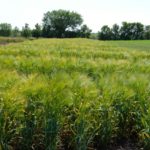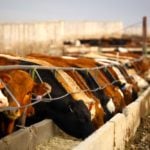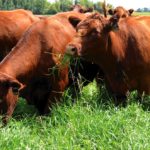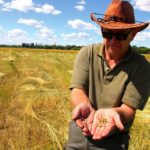
Tag Archives Forages

Environmental goods and services offer more questions than answers
Research on the Record with Reynold Bergen
The beef industry takes pride in how forage, grazing and beef production benefit the environment. These environmental goods and services (EG&S) include carbon sequestration, plant and wildlife habitat, reduced soil erosion, watershed recharging, scenery, etc. While consumers pay for beef, the EG&S are free. For instance, many ducks need grasslands and wetlands to nest and […] Read more

Why variety matters when growing barley for silage
Nutrition with John McKinnon
When growing silage, particularly barley silage, most producers select varieties with proven agronomic traits such as yield, disease and lodging resistance. In contrast, relatively little information is available on the nutritional value of the numerous barley varieties that are available for seeding. Recently a joint research project was run at the University of Saskatchewan and […] Read more

The feed barley outlook
Market Talk with Jerry Klassen
It’s that time of year when I receive many calls from cattle producers with regard to the price outlook for feed barley. This past winter, feed barley in southern Alberta has readily traded in the range of $155/mt to $165/mt delivered, while values in central Alberta are usually a $10/mt discount. The 2016-17 crop year […] Read more

Annual clovers to the rescue
Annual clover may be just the remedy if your pastures and hayland are looking a little under the weather this spring. Performance Seed, a newly established forage seed company at Lethbridge, Alta., is introducing two new low no-bloat annual clover varieties that show good potential as stand-alone crops or in blends for grazing, hay, silage […] Read more

Sainfoin, alfalfa and grass mixtures being tested
High legume pasture project in process
A sprinkling of a new sainfoin was enough to ignite renewed interest in high legume pastures across Alberta and British Columbia last year. The case for high legume pastures was made long ago, both in research trials and in the field by experienced producers with the skill and nerve to turn up the alfalfa content […] Read more

At Pickseed, forages are No. 1
Acquisition by a Danish company has allowed a sharp increase in research trials across the country
Forages may lack for attention in Canada’s overall research budget, but not at Pickseed, which has long focused most of its attention on the forage and turf sectors. Now owned by Denmark’s DFL-Trifolium, Pickseed operates seven research stations across Canada, with its main facility in Lindsay, Ont., and another near Port Hope. There are also […] Read more

Grass is a crop too
Just because forage is on marginal land doesn’t mean it should get marginal management, says a recent Beef Cattle Research Council study
If grain farmers routinely fertilize their crops to get higher yields and profits, why don’t forage producers do the same to their pastures? That question is at the heart of a recent Beef Cattle Research Council study into improving forage yields in Canada. The study notes that while annual crops have seen significant yield increases […] Read more

The challenges of growing quality forages
There are many reasons why production and quality may be less than ideal
Perception that forages are too weather-dependent or that producers plant one year and leave them alone for three must be challenged. The name varies from farm to farm and from one region of the country to another. Some refer to it under the blanket term “forage” while others attempt to be more specific — hay, […] Read more

Deciding on cover crop blends
Figuring out what to use in a cover crop blend can be an intimidating process. What species to use? What seeding rate? When should they be seeded? All would influence how the blend would look, work, and the success of it. There is some science involved, but making it work is as much art as[...]
Read more
Read more

Who will breed the next generation?
Forages aren’t only suffering from a shortage of research dollars, but a shortage of researchers to do the work if the money were available
See if you can answer these two skill-testing agricultural questions. What is the largest crop in Canada? Which crop has one of the poorest records for funding research and breeding programs? If you answered “forages” to both, you’re right. You’ve also put your finger on a chronic problem in Canada’s forage industry. Statistics show the[...]
Read more
Read more



